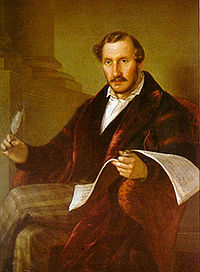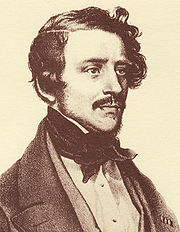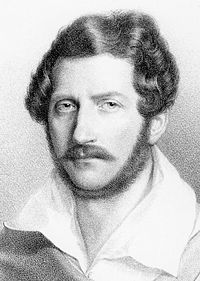- Gaetano Donizetti
-
Domenico Gaetano Maria Donizetti (Italian pronunciation: [doˈmeːniko gaeˈtaːno maˈɾia doniˈdzetti]) (29 November 1797 – 8 April 1848) was an Italian composer from Bergamo, Lombardy. His best-known works are the operas L'elisir d'amore (1832), Lucia di Lammermoor (1835), and Don Pasquale (1843), all in Italian, and the French operas La favorite and La fille du régiment (both from 1840). Along with Vincenzo Bellini and Gioachino Rossini, he was a leading composer of bel canto opera.
Contents
Biography
The youngest of three sons, Donizetti was born in 1797 in Bergamo's Borgo Canale quarter located just outside the city walls. His family was very poor with no tradition of music, his father being the caretaker of the town pawnshop. Nevertheless, Donizetti received some musical instruction from Simon Mayr, a German composer of internationally successful operas who had become maestro di cappella at Bergamo's principal church in 1802.
Donizetti was not especially successful as a choirboy, but in 1806 he was one of the first pupils to be enrolled at the Lezioni Caritatevoli school, founded by Mayr, in Bergamo through a full scholarship. He received detailed training in the arts of fugue and counterpoint, and it was here that he launched his operatic career. After some minor compositions under the commission of Paolo Zanca, Donizetti wrote his fourth opera, Zoraida di Granata. This work impressed Domenico Barbaia, a prominent theatre manager, and Donizetti was offered a contract to compose in Naples. Writing in Rome and Milan in addition to Naples, Donizetti achieved some popular success in the 1820s (although critics were often unimpressed), but was not well known internationally until 1830, when his Anna Bolena was premiered in Milan. He almost instantly became famous throughout Europe. L'elisir d'amore, a comedy produced in 1832, came soon after, and is deemed one of the masterpieces of 19th-century opera buffa (as is his Don Pasquale, written for Paris in 1843). Shortly after L'elisir d'amore, Donizetti composed Lucia di Lammermoor, based on the Sir Walter Scott novel The Bride of Lammermoor. It became his most famous opera, and one of the high points of the bel canto tradition, reaching stature similar to Bellini's Norma.
After the success of Lucrezia Borgia (1833) consolidated his reputation, Donizetti followed the paths of both Rossini and Bellini by visiting Paris, but his opera Marin Faliero suffered by comparison with Bellini's I puritani, and he returned to Naples to produce his already-mentioned masterpiece, Lucia di Lammermoor. As Donizetti's fame grew, so did his engagements, as he was further hired to write in both France and Italy. In 1838, he moved to Paris after the Italian censor objected to the production of Poliuto (on the grounds that such a sacred subject was inappropriate for the stage); there he wrote La fille du régiment, which became another success.
As a conductor, he led the premiere of Rossini's Stabat Mater.
Donizetti's wife, Virginia Vasselli, gave birth to three children, none of whom survived. Within a year of his parents' deaths, his wife died from cholera. By 1843, Donizetti exhibited symptoms of syphilis and probable bipolar disorder. After being institutionalized in 1845, he was sent to Paris, where he could be cared for. After visits from friends, including Giuseppe Verdi, Donizetti was sent back to Bergamo, his hometown. After several years in the grip of insanity, he died in 1848 in the house of the noble family Scotti. After his death Donizetti was buried in the cemetery of Valtesse but in the late 19th century his body was transferred to Bergamo's Basilica of Santa Maria Maggiore near the grave of his teacher Simon Mayr.
Donizetti is best known for his operatic works, but he also wrote music in a number of other forms, including some church music, a number of string quartets, and some orchestral works.
He was the younger brother of Giuseppe Donizetti, who had become, in 1828, Instructor General of the Imperial Ottoman Music at the court of Sultan Mahmud II (1808–1839).
Works
Donizetti was a prolific composer. He composed about 75 operas, 16 symphonies, 19 string quartets, 193 songs, 45 duets, 3 oratorios, 28 cantatas, instrumental concertos, sonatas, and other chamber pieces.
Operas
1816–1819
- Il Pigmalione (written 1816; premiere: 13 October 1960, Teatro Donizetti, Bergamo)
- Olimpiade (1817, incomplete, libretto by Metastasio)
- L'ira di Achille (1817)
- Enrico di Borgogna (14 November 1818, Teatro San Luca, Venice)
- Una follia (17 December 1818, Teatro San Luca, Venice) (lost)
- I piccioli virtuosi ambulanti (1819), opera buffa in one act
- Pietro il Grande zar di tutte le Russie ossia Il Falegname di Livonia (26 December 1819, Teatro San Samuele, Venice),
1820–1824
- Le nozze in villa (1820; 1821? Teatro Vecchio, Mantua)
- Zoraida di Granata or Zoraïda di Granata (28 January 1822, Teatro Argentina, Rome, rev. 7 January 1824 at the same theatre)
- La Zingara (12 May 1822, Teatro Nuovo, Naples)
- La lettera anonima (29 June 1822, Teatro del Fondo, Naples)
- Chiara e Serafina, ossia I pirati (26 October 1822, Teatro alla Scala, Milan)
- Alfredo il grande (2 July 1823, Teatro San Carlo, Naples)
- Il fortunato inganno (3 September 1823, Teatro Nuovo, Naples)
- L'ajo nell'imbarazzo (4 February 1824, Teatro Valle, Rome)
- Emilia di Liverpool (L'eremitaggio di Liverpool) (28 July 1824, Teatro Nuovo, Naples)
1825–1829
- Alahor in Granata (7 January 1826 Teatro Carolino, Palermo)
- Don Gregorio [rev of L'ajo nell'imbarazzo] (11 June 1826, Teatro Nuovo, Naples)
- Elvida (6 July 1826, Teatro San Carlo, Naples)
- Gabriella di Vergy (written: 1826; premiere: 29 November 1869, Teatro San Carlo, Naples) (Gabriella)
- Olivo e Pasquale (7 January 1827 Teatro Valle, Rome)
- Olivo e Pasquale [rev] (1 September 1827, Teatro Nuovo, Naples)
- Otto mesi in due ore (13 May 1827, Teatro Nuovo, Naples) (Gli esiliati in Siberia)
- Il borgomastro di Saardam (19 August 1827, Teatro del Fondo, Naples)
- Le convenienze ed inconvenienze teatrali, also known as Viva la mamma (21 November 1827, Teatro Nuovo, Naples)
- L'esule di Roma, ossia Il proscritto (1 January 1828, Teatro San Carlo, Naples)
- Emilia di Liverpool [rev] (8 March 1828, Teatro Nuovo, Naples)
- Alina, regina di Golconda (12 May 1828, Teatro Carlo Felice, Genoa)
- Gianni di Calais (2 August 1828, Teatro del Fondo, Naples)
- Il paria (12 January 1829, Teatro San Carlo, Naples)
- Il giovedi grasso (Il nuovo Pourceaugnac) (26 February 1829?, Teatro del Fondo, Naples)
- Il castello di Kenilworth (6 July 1829, Teatro San Carlo, Naples)
- Alina, regina di Golconda [rev] (10 October 1829, Teatro Valle, Rome)
1830–1834
- I pazzi per progetto (6 February 1830, Teatro San Carlo, Naples)
- Il diluvio universale (28 February 1830, Teatro San Carlo, Naples)
- Imelda de' Lambertazzi (5 September 1830, Teatro San Carlo, Naples)
- Anna Bolena (26 December 1830, Teatro Carcano, Milan)
- Le convenienze ed inconvenienze teatrali [rev of Le convenienze teatrali] (20 April 1831, Teatro Canobbiana, Milan)
- Gianni di Parigi (written: 1831; premiere: 10 September 1839, Teatro alla Scala Milan)
- Francesca di Foix (30 May 1831, Teatro San Carlo, Naples)
- La romanzesca e l'uomo nero (or La romanziera e l'uomo nero) (18 June 1831, Teatro del Fondo, Naples) (arias and ensembles survive but spoken dialogue is lost)
- Fausta (12 January 1832, Teatro San Carlo, Naples)
- Ugo, conte di Parigi (13 March 1832, Teatro alla Scala Milan)
- L'elisir d'amore (12 May 1832, Teatro Canobbiana, Milan)
- Sancia di Castiglia (4 November 1832, Teatro San Carlo, Naples)
- Il furioso all'isola di San Domingo (2 January 1833, Teatro Valle, Rome)
- Otto mesi in due ore [rev] (1833, Livorno)
- Parisina (17 March 1833, Teatro della Pergola, Florence)
- Torquato Tasso (9 September 1833, Teatro Valle, Rome)
- Lucrezia Borgia (26 December 1833, Teatro alla Scala Milan)
- Il diluvio universale [rev] (17 January 1834, Teatro Carlo Felice, Genoa)
- Rosmonda d'Inghilterra (27 February 1834, Teatro della Pergola, Florence)
- Maria Stuarda [rev] (Buondelmonte) (18 October 1834, Teatro San Carlo, Naples)
- Gemma di Vergy (26 October 1834, Teatro alla Scala Milan)
1835–1839
- Maria Stuarda (30 December 1835, Teatro alla Scala Milan)
- Marin Faliero (12 March 1835, Théâtre-Italien, Paris)
- Lucia di Lammermoor (26 September 1835, Teatro San Carlo, Naples)
- Belisario (4 February 1836, Teatro La Fenice, Venice)
- Il campanello di notte (1 June 1836, Teatro Nuovo, Naples)
- Betly, o La capanna svizzera (21 August 1836, Teatro Nuovo, Naples)
- L'assedio di Calais (19 November 1836, Teatro San Carlo, Naples)
- Pia de' Tolomei (18 February 1837, Teatro Apollo, Venice)
- Pia de' Tolomei [rev] (31 July 1837, Sinigaglia)
- Betly [rev] ((?) 29 September 1837, Teatro del Fondo, Naples)
- Roberto Devereux (28 October 1837, Teatro San Carlo, Naples)
- Maria de Rudenz (30 January 1838, Teatro La Fenice, Venice)
- Gabriella di Vergy [rev] (written: 1838; August 1978 recording, London)
- Poliuto (written: 1838; premiere: 30 November 1848, Teatro San Carlo, Naples)
- Pia de' Tolomei [rev 2] (30 September 1838, Teatro San Carlo, Naples)
- Lucie de Lammermoor [rev of Lucia di Lammermoor] (6 August 1839, Théâtre de la Renaissance, Paris)
- Le duc d'Albe (written: 1839; premiere: 22 March 1882, Teatro Apollo, Rome) (Il duca d'Alba)
1840–1845
- Lucrezia Borgia [rev] (11 January 1840, Teatro alla Scala Milan)
- Poliuto [rev] (Les martyrs) (10 April 1840, Paris Opera (Salle Le Peletier)
- La fille du régiment (11 February 1840, Opéra-Comique, Paris)
- L'ange de Nisida (1839; ?)
- Lucrezia Borgia [rev 2] (31 October 1840, Théâtre-Italien, Paris)
- La favorite [rev of L'ange de Nisida] (2 December 1840, Paris Opera (Salle Le Peletier)
- Adelia (11 February 1841, Teatro Apollo, Rome)
- Rita (Deux hommes et une femme) (written: 1841; premiere: 7 May 1860, Opéra-Comique, Paris)
- Maria Padilla (26 December 1841, Teatro alla Scala Milan)
- Linda di Chamounix (19 May 1842, Kärntnertortheater, Vienna)
- Linda di Chamounix [rev] (17 November 1842, Théâtre-Italien, Paris)
- Caterina Cornaro (18 January 1844, Teatro San Carlo, Naples)
- Don Pasquale (3 January 1843, Théâtre-Italien, Paris)
- Maria di Rohan (5 June 1843, Kärntnertortheater, Vienna)
- Dom Sébastien (13 November 1843, Paris Opera (Salle Le Peletier)
- Dom Sébastien [rev] (6 February 1845, Kärntnertortheater, Vienna)
Choral works
- Ave Maria
- Grande Offertorio
- Il sospiro
- Messa da Requiem
- Messa di Gloria e Credo
- Miserere (Psalm 50)
Orchestral works
- Allegro for Strings in C major
- Larghetto, tema e variazioni in E flat major
- Sinfonia Concertante in D major (1818)
- Sinfonia for Winds in G minor (1817)
- Sinfonia in A major
- Sinfonia in C major
- Sinfonia in D major
- Sinfonia in D minor
Concertos
- Concertino for Clarinet in B flat major
- Concertino for English Horn in G major (1816)
- Concertino in C minor for flute and chamber orchestra (1819)
- Concertino for Flute and Orchestra in C major
- Concertino for Flute and Orchestra in D major
- Concertino for Oboe in F major
- Concertino for Violin and Cello in D minor
- Concerto for 2 Clarinets "Maria Padilla"
- Concerto for Violin and Cello in D minor
Chamber works
- Andante sostenuto for Oboe and Harp in F minor
- Introduction for Strings in D major
- Larghetto and Allegro for Violin and Harp in G minor
- Largo/Moderato for Cello and Piano in G minor
- Nocturnes (4) for Winds and Strings
- Quartet for Strings in D major
- Quartet for Strings no 3 in C minor: 2nd movement, Adagio ma non troppo
- Quartet for Strings no 4 in D major
- Quartet for Strings no 5 in E minor
- Quartet for Strings no 5 in E minor: Larghetto
- Quartet for Strings no 6 in G minor
- Quartet for Strings no 7 in F minor
- Quartet for Strings no 8 in B flat major
- Quartet for Strings no 9 in D minor
- Quartet for Strings no 10 in G minor
- Quartet for Strings no 11 in C major
- Quartet for Strings no 12 in C major
- Quartet for Strings no 13 in A major
- Quartet for Strings no 14 in D major
- Quartet for Strings no 15 in F major
- Quartet for Strings no 16 in B minor
- Quartet for Strings no 17 in D major
- Quartet for Strings no 18 in E minor
- Quartet for Strings no 18 in E minor: Allegro
- Quintet for Guitar and Strings no 2 in C major
- Solo de concert
- Sonata for Flute and Harp
- Sonata for Flute and Piano in C minor
- Sonata for Oboe and Piano in F major
- Study for Clarinet no 1 in B flat major
- Trio for Flute, Bassoon and Piano in F major
Piano works
- Adagio and Allegro for Piano in G major
- Allegro for Piano in C major
- Allegro for Piano in F minor
- Fugue for Piano in G minor
- Grand Waltz for Piano in A major
- Larghetto for Piano in A minor "Una furtiva lagrima"
- Larghetto for Piano in C major
- Pastorale for Piano in E major
- Presto for Piano in F minor
- Sinfonia for Piano in A major
- Sinfonia for Piano no 1 in C major
- Sinfonia for Piano no 1 in D major
- Sinfonia for Piano no 2 in C major
- Sinfonia for Piano no 2 in D major
- Sonata for Piano in C major
- Sonata for Piano in F major
- Sonata for Piano in G major
- Variations for Piano in E major
- Variations for Piano in G major
- Waltz for Piano in A major
- Waltz for Piano in C major
- Waltz for Piano in C major "The Invitation"
Media
Quotations
- "Ah, by Bacchus, with this aria I shall receive universal applause. People will say to me, “Bravo maestro!”
- I, in a very modest manner, shall walk about with bowed head; I’ll have rave reviews…I can become immortal…
- My mind is vast, my genius swift...
- And at composing, a thunderbolt am I."
- (From a poem composed by 14-year-old Gaetano Donizetti)
- "Donizetti, when asked which of his own operas he thought the best, spontaneously replied, 'How can I say which? A father always has a preference for a crippled child, and I have so many.'" (Louis Engel: "From Mozart to Mario", 1886)
References
- Sources
- Allitt, John Stewart, Gaetano Donizetti – Pensiero, musica, opere scelte, Milano: Edizione Villadiseriane, 2003
- Allitt, John Stewart, Donizetti – in the light of romanticism and the teaching of Johann Simon Mayr, Shaftesbury, Dorset, UK: Element Books, 1991. Also see Allitt's website http://www.johnstewartallitt.com/
- Ashbrook, William: Donizetti and his Operas, Cambridge:Cambridge University Press 1982. Ashbrook also wrote an earlier life entitled Donizetti in 1965.
- Bini, Annalisa and Jeremy Commons, Le prime rappresentazioni delle opere di Donizetti nella stampa coeva, Milan: Skira, 1997
- Black, John, Donizetti's Operas in Naples 1822–1848, London: The Donizetti Society, 1982
- Cassaro, James P., Gaetano Donizetti – A Guide to Research, New York: Garland Publishing. 2000
- Gossett, Philip, "Anna Bolena" and the Artistic Maturity of Gaetano Donizetti, Oxford: Oxford University Press, 1985
- Kantner, Leopold M (Ed.), Donizetti in Wien, papers from a symposium in various languages (ISBN 3-7069-0006-8 / ISSN 156,00-8921). Published by Primo Ottocento, available from Edition Praesens.
- Keller, Marcello Sorce, "Gaetano Donizetti: un bergamasco compositore di canzoni napoletane", Studi Donizettiani, III(1978), 100- 107.
- Keller, Marcello Sorce, "Io te voglio bene assaje: a Famous Neapolitan Song Traditionally Attributed to Gaetano Donizetti", The Music Review, XLV (1984), no. 3- 4, 251- 264. Also published as: "Io te voglio bene assaje: una famosa canzone napoletana tradizionalmente attribuita a Gaetano Donizetti, La Nuova Rivista Musicale Italiana, 1985, no. 4, 642- 653.
- Sadie, Stanley (Ed.), The New Grove Dictionary of Music and Musicians, Volume 7, London: Macmillan Publishers Ltd., 2001, pp. 761–796. The 1980 edition article, by William Ashbrook and Julian Budden, was also reprinted in The New Grove Masters of Italian Opera, London: Papermac, 1984, pp. 93–154.
- Sadie, Stanley (Ed.), The New Grove Dictionary of Opera, Volume 1, London: Macmillan Publishers Ltd., 1997, pp. 1201–1221.
- Saracino, Egidio (Ed.), Tutti I libretti di Donizetti, Garzanti Editore, 1993.
- Weinstock, Herbert, Donizetti and the World of Opera in Italy, Paris and Vienna in the First Half of the Nineteenth Century, New York: Random House, 1963.
- Petténi, Giuliano Donati, Donizetti, Milano: Fratelli Treves Editori, 1930
- Zavadini, Guuido, Donizetti: Vita – Musiche- Epistolario, Bergamo, 1948
External links
- Donizetti Society website
- Donizetti works at Casa Ricordi
- List of Donizetti operas at opera.stanford.edu
- Donizetti article on Manitoba Opera website
- Donizetti biography on Arizona Opera website
- 2 Donizetti libretti on intratext.com
- Sheet music
- Free scores by Gaetano Donizetti at the International Music Score Library Project
- Free scores by Gaetano Donizetti in the Choral Public Domain Library (ChoralWiki)
- Recordings
Categories:- 1797 births
- 1848 deaths
- People from Bergamo
- Opera composers
- Romantic composers
- Italian composers
- People with bipolar disorder
- Compositions by Gaetano Donizetti
Wikimedia Foundation. 2010.



